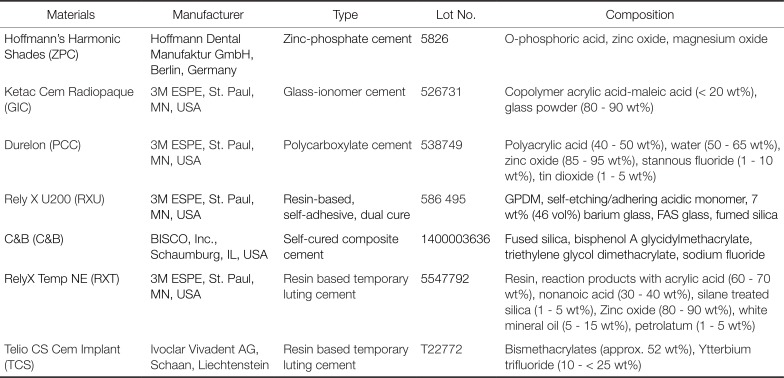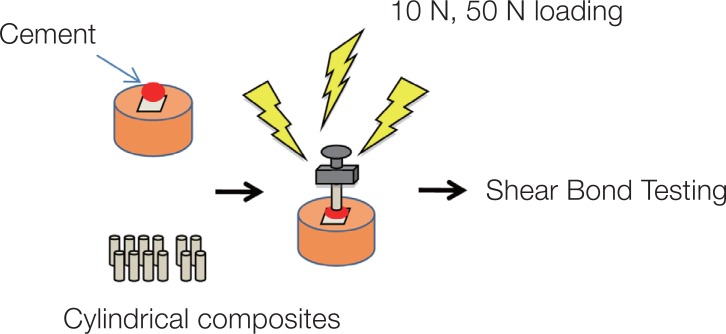1. Lee A, Okayasu K, Wang HL. Screw- versus cement-retained implant restorations: current concepts. Implant Dent. 2010; 19:8–15. PMID:
20147811.

2. Mehl C, Harder S, Steiner M, Vollrath O, Kern M. Influence of cement film thickness on the retention of implant-retained crowns. J Prosthodont. 2013; 22:618–625. PMID:
23915027.

3. Mehl C, Harder S, Shahriari A, Steiner M, Kern M. Influence of abutment height and thermocycling on retrievability of cemented implant-supported crowns. Int J Oral Maxillofac Implants. 2012; 27:1106–1115. PMID:
23057023.
4. Hebel KS, Gajjar RC. Cement-retained versus screw-retained implant restorations: achieving optimal occlusion and esthetics in implant dentistry. J Prosthet Dent. 1997; 77:28–35. PMID:
9029462.

5. Breeding LC, Dixon DL, Bogacki MT, Tietge JD. Use of luting agents with an implant system: Part I. J Prosthet Dent. 1992; 68:737–741. PMID:
1432793.

6. Heinemann F, Mundt T, Biffar R. Retrospective evaluation of temporary cemented, tooth and implant supported fixed partial dentures. J Craniomaxillofac Surg. 2006; 34:86–90. PMID:
17071399.

7. Chaar MS, Att W, Strub JR. Prosthetic outcome of cement-retained implant-supported fixed dental restorations: a systematic review. J Oral Rehabil. 2011; 38:697–711. PMID:
21395638.

8. Mehl C, Harder S, Schwarz D, Steiner M, Vollrath O, Kern M. In vitro influence of ultrasonic stress, removal force preload and thermocycling on the retrievability of implant-retained crowns. Clin Oral Implants Res. 2012; 23:930–937. PMID:
21722192.

9. Good ML, Mitchell CA, Pintado MR, Douglas WH. Quantification of all-ceramic crown margin surface profile from tryin to 1-week post-cementation. J Dent. 2009; 37:65–75. PMID:
19013703.

10. Watanabe K, Ohnishi E, Kaneshima T, Mine A, Yatani H. Porcelain veneer bonding to enamel with plasma-arc light resin curing. Dent Mater J. 2002; 21:61–68. PMID:
12046523.

11. Carter SM, Wilson PR. The effects of die-spacing on post-cementation crown elevation and retention. Aust Dent J. 1997; 42:192–198. PMID:
9241932.
12. Dixon DL, Breeding LC, Lilly KR. Use of luting agents with an implant system: Part II. J Prosthet Dent. 1992; 68:885–890. PMID:
1494113.

13. Vermilyea SG, Kuffler MJ, Huget EF. The effects of die relief agent on the retention of full coverage castings. J Prosthet Dent. 1983; 50:207–210. PMID:
6352908.

14. Hembree JH Jr, Cooper EW Jr. Effect of die relief on retention of cast crowns and inlays. Oper Dent. 1979; 4:104–107. PMID:
398977.
15. Haddad MF, Rocha EP, Assunção WG. Cementation of prosthetic restorations: from conventional cementation to dental bonding concept. J Craniofac Surg. 2011; 22:952–958. PMID:
21558917.
16. Bagheri R. Film thickness and flow properties of resin-based cements at different temperatures. J Dent (Shiraz). 2013; 14:57–63. PMID:
24724120.
17. Wilson PR. Low force cementation. J Dent. 1996; 24:269–273. PMID:
8783532.

18. Goracci C, Cury AH, Cantoro A, Papacchini F, Tay FR, Ferrari M. Microtensile bond strength and interfacial properties of self-etching and self-adhesive resin cements used to lute composite onlays under different seating forces. J Adhes Dent. 2006; 8:327–335. PMID:
17080881.
19. Piemjai M. Effect of seating force, margin design, and cement on marginal seal and retention of complete metal crowns. Int J Prosthodont. 2001; 14:412–416. PMID:
12066634.
20. Fonseca RG, de Almeida JG, Haneda IG, Adabo GL. Effect of metal primers on bond strength of resin cements to base metals. J Prosthet Dent. 2009; 101:262–268. PMID:
19328279.

21. Yoshida K, Kamada K, Tanagawa M, Atsuta M. Shear bond strengths of three resin cements used with three adhesive primers for metal. J Prosthet Dent. 1996; 75:254–261. PMID:
8648571.

22. Matinlinna JP, Lung CYK, Tsoi JKH. Silane adhesion mechanism in dental applications and surface treatments: A review. Dent Mater. 2018; 34:13–28. PMID:
28969848.

23. Özcan M, Matinlinna J. Surface conditioning protocol for the adhesion of resin-based cements to base and noble alloys: How to condition and why? J Adhes Dent. 2015; 17:372–373. PMID:
26369305.
24. Cherkasski B, Wilson PR. The effect of oscillation, low seating force and dentine surface treatment on pulpward pressure transmission during crown cementation: a laboratory study. J Oral Rehabil. 2003; 30:957–963. PMID:
12974853.

25. Black S, Amoore JN. Measurement of forces applied during the clinical cementation of dental crowns. Physiol Meas. 1993; 14:387–392. PMID:
8401279.

26. Montgomery DC. Design and analysis of experiments. 8th ed. NC: John Wiley & Sons;2012. p. 174–188.
27. Jørgensen KD. Factors affecting the film thickness of zinc phosphate cements. Acta Odontol Scand. 1960; 18:479–490.

28. D'Souza R, Shetty O, Puppala P, Shetty N. A better bond: Luting simplified. Int J Prosthet Rest Dent. 2012; 2:77–81.
29. Mitchell CA, Abbariki M, Orr JF. The influence of luting cement on the probabilities of survival and modes of failure of cast full-coverage crowns. Dent Mater. 2000; 16:198–206. PMID:
10762680.

30. Sen D. Cementation. 1st ed. Istanbul: Quintessence Publishing;2012. p. 9–31.
31. Mansour A, Ercoli C, Graser G, Tallents R, Moss M. Comparative evaluation of casting retention using the ITI solid abutment with six cements. Clin Oral Implants Res. 2002; 13:343–348. PMID:
12175370.

32. Hattar S, Hatamleh M, Khraisat A, Al-Rabab'ah M. Shear bond strength of self-adhesive resin cements to base metal alloy. J Prosthet Dent. 2014; 111:411–415. PMID:
24355505.

33. Bauer J, Costa JF, Carvalho CN, Souza DN, Loguercio AD, Grande RH. Influence of alloy microstructure on the microshear bond strength of basic alloys to a resin luting cement. Braz Dent J. 2012; 23:490–495. PMID:
23306223.

34. Raeisosadat F, Ghavam M, Hasani Tabatabaei M, Arami S, Sedaghati M. Bond strength of resin cements to noble and base metal alloys with different surface treatments. J Dent (Tehran). 2014; 11:596–603. PMID:
25628687.
35. Kious AR, Roberts HW, Brackett WW. Film thicknesses of recently introduced luting cements. J Prosthet Dent. 2009; 101:189–192. PMID:
19231571.

36. Anusavice KJ. Phillips' Science of dental materials. 11th ed. Missouri: W.B. Saunders Company;2003. p. 621–654.
37. Sakaguchi RL, Powers JM. Craig's restorative dental materials. 13th ed. Philadelphia: Elsevier Mosby;2012. p. 327–347.
38. Almilhatti HJ, Neppelenbroek KH, Vergani CE, Machado AL, Pavarina AC, Giampaolo ET. Adhesive bonding of resin composite to various titanium surfaces using different metal conditioners and a surface modification system. J Appl Oral Sci. 2013; 21:590–596. PMID:
24473727.

39. Fawzy AS, El-Askary FS. Effect acidic and alkaline/heat treatments on the bond strength of different luting cements to commercially pure titanium. J Dent. 2009; 37:255–263. PMID:
19167146.

40. Kern M, Thompson VP. Durability of resin bonds to pure titanium. J Prosthodont. 1995; 4:16–22. PMID:
7670606.

41. Technical data sheet RelyX U200. St. Paul, MN, USA: 3M ESPE;2011.
42. Safety data sheet C&B. Schaumburg, IL, USA: BISCO, Inc.;2015.
43. Yoshida K, Kamada K, Sawase T, Atsuta M. Effect of three adhesive primers for a noble metal on the shear bond strengths of three resin cements. J Oral Rehabil. 2001; 28:14–19. PMID:
11298904.

44. McIntyre FM, Sorensen SE, Carter JM, Johnson RR. The effect of film thickness on the bond strength of polycarboxylate cement. Int J Prosthodont. 1994; 7:461–467. PMID:
7802915.
45. Orsi IA, Varoli FK, Pieroni CH, Ferreira MC, Borie E. In vitro tensile strength of luting cements on metallic substrate. Braz Dent J. 2014; 25:136–140. PMID:
25140718.

46. Subramaniam P, Kondae S, Gupta KK. Retentive strength of luting cements for stainless steel crowns: an in vitro study. J Clin Pediatr Dent. 2010; 34:309–312. PMID:
20831131.

47. Hibino Y, Kuramochi K, Hoshino T, Moriyama A, Watanabe Y, Nakajima H. Relationship between the strength of glass ionomers and their adhesive strength to metals. Dent Mater. 2002; 18:552–557. PMID:
12191669.








 PDF
PDF ePub
ePub Citation
Citation Print
Print




 XML Download
XML Download